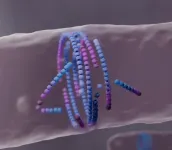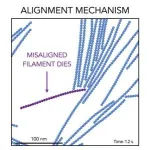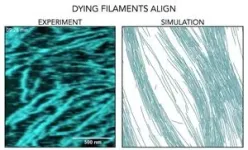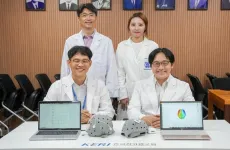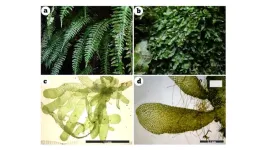(Press-News.org) A previously unknown mechanism of active matter self-organization essential for bacterial cell division follows the motto ‘dying to align’: Misaligned filaments ‘die’ spontaneously to form a ring structure at the center of the dividing cell. The study, led by the Šarić group at the Institute of Science and Technology Austria (ISTA), was published in Nature Physics. The work could find applications in developing synthetic self-healing materials.
How does matter, lifeless by definition, self-organize and make us alive? One of the hallmarks of life, self-organization, is the spontaneous formation and breakdown of biological active matter. However, while molecules constantly fall in and out of life, one may ask how they ‘know’ where, when, and how to assemble, and when to stop and fall apart.
Researchers around Professor Anđela Šarić and PhD student Christian Vanhille Campos at the Institute of Science and Technology Austria (ISTA) address these questions in the context of bacterial cell division. They developed a computational model for the assembly of a protein called FtsZ, an example of active matter. During cell division, FtsZ self-assembles into a ring structure at the center of the dividing bacterial cell. This FtsZ ring–called the bacterial division ring–was shown to help form a new ‘wall’ that separates the daughter cells. However, essential physical aspects of FtsZ self-assembly have not been explained to this day. Now, computational modelers from the Šarić group team up with experimentalists from Séamus Holden’s group at The University of Warwick, UK, and Martin Loose’s group at ISTA to reveal an unexpected self-assembly mechanism. Their computational work demonstrates how misaligned FtsZ filaments react when they hit an obstacle. By ‘dying’ and re-assembling, they favor the formation of the bacterial division ring, a well-aligned filamentous structure. These findings could have applications in the development of synthetic self-healing materials.
Treadmilling, the adaptive power of molecular turnover
FtsZ forms protein filaments that self-assemble by growing and shrinking in a continuous turnover. This process, called ‘treadmilling,’ is the constant addition and removal of subunits at opposite filament ends. Several proteins have been shown to treadmill in multiple life forms – such as bacteria, animals, or plants. Scientists have previously thought of treadmilling as a form of self-propulsion and modeled it as filaments that move forward. However, such models fail to capture the constant turnover of subunits and overestimate the forces generated by the filaments’ assembly. Thus, Anđela Šarić and her team set out to model how FtsZ subunits interact and spontaneously form filaments by treadmilling. “Everything in our cells is in a constant turnover. Thus, we need to start thinking of biological active matter from the prism of molecular turnover and in a way that adapts to the outside environment,” says Šarić.
Mortal filaments: dying to align
What they found was striking. In contrast to self-propelled assemblies that push the surrounding molecules and create a ‘bump’ felt at long molecular distances, they saw that misaligned FtsZ filaments started ‘dying’ when they hit an obstacle. “Active matter made up of mortal filaments does not take misalignment lightly. When a filament grows and collides with obstacles, it dissolves and dies,” says the first author Vanhille Campos. Šarić adds, “Our model demonstrates that treadmilling assemblies lead to local healing of the active material. When misaligned filaments die, they contribute to a better overall assembly.” By incorporating the cell geometry and filament curvature into their model, they showed how the death of misaligned FtsZ filaments helped form the bacterial division ring.
Theory-driven research, confirmed by collaborations with experimentalists
Driven by the physical theories of molecular interactions, Šarić and her team soon made two independent encounters with experimental groups that helped confirm their results. At a diverse and multidisciplinary conference called ‘Physics Meets Biology,’ they met Séamus Holden, who worked on imaging bacterial ring formation in live cells. At this meeting, Holden presented exciting experimental data showing that the death and birth of FtsZ filaments were essential for the formation of the division ring. This suggested that treadmilling had a crucial role in this process. “Satisfyingly, we found that FtsZ rings in our simulations behaved in the same way as the Bacillus subtilis division rings that Holden’s team imaged,” says Vanhille Campos.
In a similar strike of luck, relocating from University College London to ISTA allowed Šarić and her group to team up with Martin Loose, who had been working on assembling FtsZ filaments in a controlled experimental setup in vitro. They saw that the in vitro results closely matched the simulations and further confirmed the team’s computational results. Underlining the cooperation spirit and synergy between the three groups, Šarić says, “We are all stepping outside our usual research fields and going beyond what we normally do. We openly discuss and share data, views, and knowledge, which allows us to answer questions we cannot tackle separately.”
Toward synthetic self-healing materials
Energy-driven self-organization of matter is a fundamental process in physics. The team led by Šarić now suggests that FtsZ filaments are a different type of active matter that invests energy in turnover rather than motility. “In my group, we ask how to create living matter from non-living material that looks living. Thus, our present work could facilitate the creation of synthetic self-healing materials or synthetic cells,” says Šarić. As a next step, Šarić and her team seek to model how the bacterial division ring helps build a wall that will divide the cell into two. Holden and Šarić will continue to investigate this question with the help of a recent 3.7 million Euro grant awarded by the Wellcome Trust.
END
Align or die
ISTA researchers uncover how ‘mortal filaments’ self-assemble and maintain order
2024-08-12
ELSE PRESS RELEASES FROM THIS DATE:
Breakthrough heart MRI technique accurately predicts heart failure risk in general population
2024-08-12
New research looking at more than 39,000 UK biobank participants found those with higher heart pressure estimated by Magnetic Resonance Imaging (MRI) were five times more likely to develop heart failure
Key risk factors discovered for increased heart pressure include age over 70, high blood pressure, obesity, alcohol consumption and male gender
Breakthrough by University of East Anglia and Queen Mary University of London suggests that heart MRI could potentially replace invasive diagnostic tests
Peer-reviewed – Observational Study - People
MRI scans could replace invasive heart tests, as new research shows they can reliably estimate pressures ...
Global study predicts increases in cancer cases and deaths among men, with widening disparities based on age and countries’ economic status
2024-08-12
In an analysis of 30 cancer types among men, investigators uncovered substantial disparities in cancer cases and deaths by age and countries’ economic status—disparities that are projected to widen by 2050. The study is published by Wiley online in CANCER, a peer-reviewed journal of the American Cancer Society.
Men face higher rates of cancer and cancer-related deaths than women, likely due to various factors including lower participation in cancer prevention activities; underuse of screening and treatment options; increased exposure to cancer risk factors such as smoking, alcohol consumption, and occupational exposure to carcinogens; and biological ...
USC study: Drug protects against air pollution-related Alzheimer’s signs in mice
2024-08-12
A new study led by the USC Leonard Davis School of Gerontology shows how feeding mice a drug called GSM-15606 provided protection against air pollution-related increases in proteins linked to Alzheimer’s disease.
Senior author Caleb Finch, USC University Professor and holder of the ARCO/William F. Kieschnick Chair in the Neurobiology of Aging at the USC Leonard Davis School, has studied air pollution’s effects on the brain for several years, especially the consequences of exposure to fine particulates found in pollution from automobiles, factories and more. ...
Mild Cognitive Impairment could be going unreported in rural areas of west Michigan, study suggests
2024-08-12
Grand Rapids, Mich., Aug. 12, 2024 – Corewell Health™ and Michigan State University researchers are the first in the state to use de-identified electronic health records of more than 1.5 million patients to analyze incidence rates and risk factors of mild cognitive impairment, or MCI, in rural and urban areas in West Michigan.
Results showed that many cases could be going undetected among those living in rural communities in the area, and researchers now will use the findings to develop AI tools that can detect MCI earlier among patients across the country.
The retrospective study, which included 10 years of historical patient ...
Brain electrical stimulation suppresses appetite. A new frontier in obesity treatment?
2024-08-12
The R&D on neuromodulation technology for the treatment and management of metabolic syndrome conducted by a team led by Dr. Ki-young Shin of Human Care Electro-Medical Device Research Center, Electro-Medical Equipment Research Division of KERI is underway smoothly.
Metabolic syndrome is a complex of multiple metabolic abnormalities, including obesity, high blood pressure, and high triglycerides, often caused by poor diet and lack of exercise. According to the World Health Organization (WHO), one in eight people worldwide is overweight, making obesity treatment ...
Eco-conscious fashionistas hampered by geographical barriers to return clothing
2024-08-12
Eco-conscious consumers are not well-served by clothing companies claiming green credentials, as shoppers’ location has a major impact on the effectiveness of clothing return schemes, a new study reveals.
Environmental circular economy initiatives for activewear companies are limited by where firms and consumers are located, preventing them from being fully effective.
The clothing industry is one of the biggest global polluters, with fast fashion companies creating cheap clothing that gets thrown away after one or two uses and ends up in landfill. According to the European ...
Redefining the computer whiz: research shows diverse skills valued by youth
2024-08-12
FOR A COPY OF THE STUDY AHEAD OF PUBLICATION, PLEASE ENSURE YOU ARE SIGNED UP TO TAYLOR & FRANCIS’ EMBARGO AREA AND THEN VISIT: https://newsroom.taylorandfrancisgroup.com/redefining-the-computer-whiz-research-shows-diverse-skills-valued-by-youth/
New study reveals diverse perceptions of the 'ideal' computer science student among young people.
Researchers at the University of Reading, with colleagues at King's College London, have uncovered a more nuanced view of what makes an 'ideal' computer science student, challenging long-held stereotypes of geeky, clever, ...
Fern becomes first in suborder to be classed as “independent gametophyte”
2024-08-10
Tokyo, Japan – Researchers from Tokyo Metropolitan University have discovered that the fern Hymenasplenium murakami-hatanakae can become independent gametophytes i.e. live for long periods without a spore-producing sporophyte. They collected specimens from Izu-Oshima Island, Japan, and used DNA analysis to show that this Aspleniineae fern, a suborder encompassing thirty percent of ferns on the planet, was part of this rare class. Studying the species further promises to reveal more about how ferns diversify and adapt.
The “alternation of generations” in plants and algae is the intricate cycle by which they reproduce. Each ...
Study reveals Canadian wildfires are affecting US air quality and raising health concerns
2024-08-09
Climate-driven wildfire events are rapidly transferring harmful particulate matter containing toxic chemicals over long distances, compromising air quality in the New Jersey and New York City areas, according to Rutgers Health research.
Published in Environmental Science & Technology and to be featured on the cover of the journal’s next issue, the study assessed the physical and chemical characteristics of wildfire-related particulate matter and was the first to report this characterization from a climate-driven wildfire event in the densely populated Northeast region.
“Particulate ...
As temperatures break records, many are unaware of symptoms of heat-related illnesses
2024-08-09
PHILADELPHIA – With NASA data showing that July 22, 2024, was the hottest day on record and indications that July may have been the hottest month, an Annenberg Public Policy Center survey conducted in mid-July found that most people know three of the symptoms of a heat-related illness but do not know the location of their nearest cooling center. At the same time, increasing numbers of people think that heat waves are becoming more frequent and intense and affecting their daily activities.
Knowledge of cooling centers in the case of extreme heat
Although the locations of cooling centers, or indoor air-conditioned facilities such as libraries, ...
LAST 30 PRESS RELEASES:
Bharat Innovates 2026 National Basecamp Showcases India’s Most Promising Deep-Tech Ventures
Here’s what determines whether your income level rises or falls
SCIE indexation achievement: Celebrate with Space: Science & Technology
Children’s Hospital Colorado performs region’s first pediatric heart and liver dual organ transplant
Australian team discover why quantum computers have memory problems over time
What determines the fate of a T cell?
Candida auris: genetic process revealed which could be treatment target for deadly fungal disease
Groundbreaking discovery turns household plastic recycling into anti-cancer medication
Blocking a key inflammatory pathway improves liver structure and vascular function in cirrhosis, study finds
Continuous spread: Raccoon roundworm detected in nine European countries
HKUST Engineering researchers developed a novel photodetector to enhance the performance of on-chip light monitoring
Strategic river sensors could have forewarned of Texas Camp flood disaster
Drone sampling of whale breath reveals first evidence of potentially deadly virus in Arctic
Roman soldiers defending Hadrian’s Wall infected by parasites, study finds
Pinochet’s prisoners were tormented with music but still found solace in it, a new book reveals
Fertility remains high in rural Tanzania despite access to family planning
AI-assisted device can improve autism care access
Kinetic careers
Uncovering how parasitic plants avoid attacking themselves to improve crop resistance
Nanoparticle vaccine strategy could protect against Ebola and other deadly filoviruses
Study finds brain care score can predict risk of stroke across racial groups
Key lung immune cells can intensify allergic reactions
Do hormones explain why women experience more gut pain?
New materials conduct ions in solids as easily as in liquids
Breakthrough of the Year: Renewable energy begins to eclipse fossil fuel-based sources
LLM use is reshaping scientific enterprise by increasing output, reducing quality and more
Introducing LightGen, a chip for ultra-fast, ultra-efficient generative AI
Astronomers see fireworks from violent collisions around nearby star
ACC/AHA issue new guideline on managing congenital heart disease in adults
Cosmic crash caught on camera
[Press-News.org] Align or dieISTA researchers uncover how ‘mortal filaments’ self-assemble and maintain order
